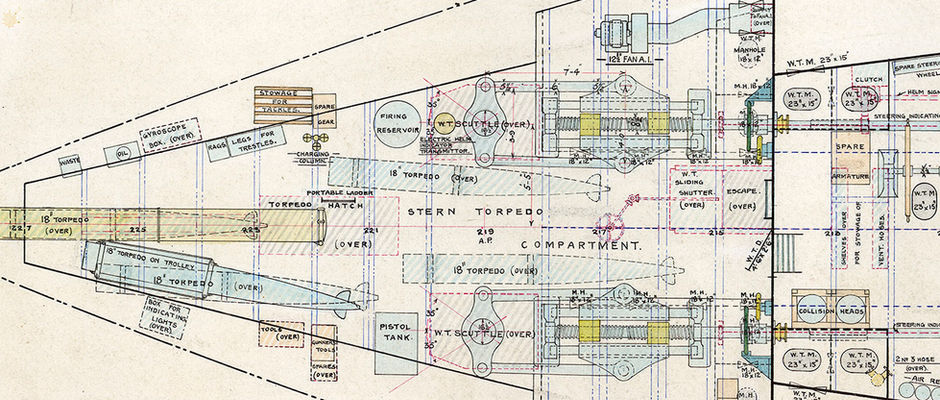
THE BIRTH OF A LEVIATHAN
VANGUARD was one of three St Vincent Class dreadnoughts built for the Royal Navy before the First World War - her sister ships were ST VINCENT and COLLINGWOOD.
Construction began in 1907 to ST VINCENT. The keel laid down in December 1907; she was built in Portsmouth, was completed in January 1910 and commissioned on 3rd May 1910 for service into the 1st Division Home Fleet.
COLLINGWOOD was second to be built - she was constructed at Devonport from February 1907, completed in April 1910 and commissioned on 19th April for the 1st Division Home Fleet .
Last to be built, at Vickers in Barrow-in-Furness, was VANGUARD. She was laid down on 2nd April 1908, launched on 22nd February 1909 and completed in February 1910. She was commissioned on 1st March 1910 into the 1st Division Home Fleet along with her sisters.
She was 500ft in length, 84ft in width, had a 27ft draught and displaced 19,250 tons.
HMS VANGUARD'S PLANS
All images of Vanguard's plans are courtesy and copyright of The National Maritime Museum, Greenwich, London.
Image: Low resolution profile of long section plan of Vanguard (J9980).

Image: Low resolution hold plan (J9985)

Image: Low resolution Forecastle and Deck Plan (J9975)

LAUNCH OF THE VANGUARD
The new battleship Vanguard was successfully launched by Mrs Reginald McKenna, wife of the First Lord of the Admiralty, from the Naval Construction Works of Messrs Vickers, Sons and Maxim on Monday 22nd February 1909. The morning held brilliant weather and large crowds assembled in the shipyard itself as well as on Walney Island opposite the slips to see the great vessel take to the water.
The launch was timed for a quarter to 12 with Mrs McKenna operating the mechanism which released the dog shores; once initiated the ship at once began to move. Her bow dropped off the ways into the water in less than a minute. The ways on which she slid down to the water were lubricated with 20 barrels of soap and £200 worth of grease. As soon as the vessel was afloat she was taken in charge by four tugs which towed her round to one of the fitting out berths in the Buccleuch Dock.
Identifying the St Vincent Dreadnoughts
Identifying the St Vincent sister ships came in the form of different banding on each of their funnels.
The after funnels were larger than the fore funnels. To distinguish between them, St Vincent had two white bands on the after funnel, Collingwood had a single white band on the after funnel and Vanguard had a single red band on both funnels.


















